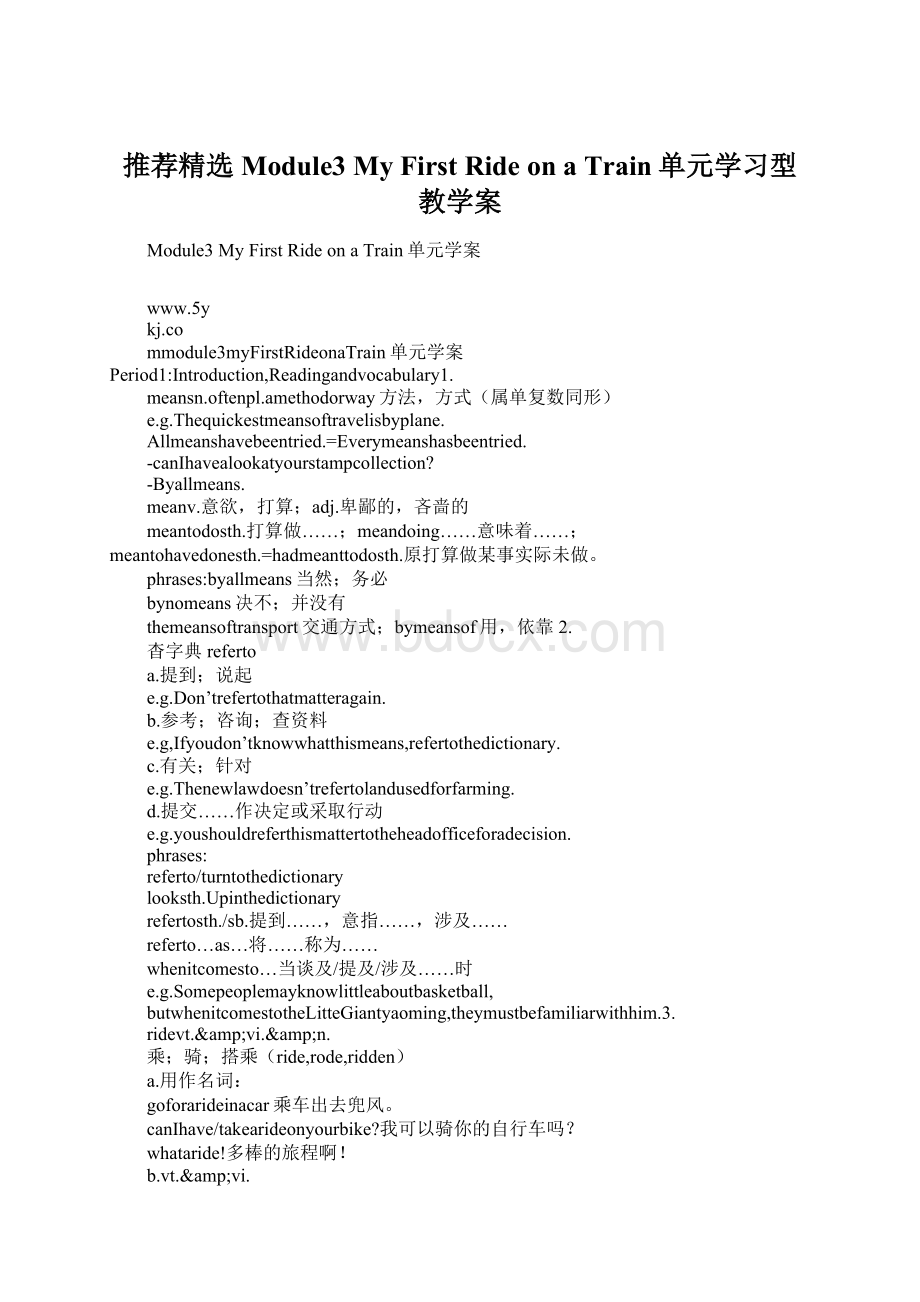推荐精选Module3 My First Ride on a Train单元学习型教学案Word文档格式.docx
《推荐精选Module3 My First Ride on a Train单元学习型教学案Word文档格式.docx》由会员分享,可在线阅读,更多相关《推荐精选Module3 My First Ride on a Train单元学习型教学案Word文档格式.docx(7页珍藏版)》请在冰豆网上搜索。

d.提交……作决定或采取行动
e.g.youshouldreferthismattertotheheadofficeforadecision.
referto/turntothedictionary
looksth.Upinthedictionary
refertosth./sb.提到……,意指……,涉及……
referto…as…将……称为……
whenitcomesto…当谈及/提及/涉及……时
e.g.Somepeoplemayknowlittleaboutbasketball,
butwhenitcomestotheLitteGiantyaoming,theymustbefamiliarwithhim.3.
ridevt.&
amp;
vi.&
n.
乘;
骑;
搭乘(ride,rode,ridden)
a.用作名词:
goforarideinacar乘车出去兜风。
canIhave/takearideonyourbike?
我可以骑你的自行车吗?
whataride!
多棒的旅程啊!
b.vt.&
vi.
Hejumpedonhishorseandrodeaway.
canyourideahorse?
注:
ride用于骑马、骑自行车时,常用作vt.,
即rideahorse;
rideabike;
用于乘公共汽车时、乘火车时,常用作vi.,即rideonabus;
rideonatrain.4.
drivevt.&
vi.驾驶;
用车送;
驱赶;
迫使;
飞跑;
猛冲
drive表示“驱使,迫使”,后面接宾补(todo;
adj.;
adv;
prep.phra.不用现在分词)
phrase:
drivesb.mad.使某人发疯;
driveoff/out赶走;
drivesb.away把某人赶走;
drivesb.intoacorner逼得某人走投无路
ride/drive
ride-乘。
可以乘车辆,也可以乘其他工具(如马、自行车等);
指车辆时,是乘车而不是开车。
drive-驾驶,驱赶。
宾语为车辆时,意为“驾驶”,是别的东西时,意为“驱赶”。
当两者用作名词,表示一段车程时无区别,如:
anhour’sride=anhour’sdirve5.
distancea.
c.n.&
u.n.距离;
间距b.
u.n远方;
远处c.
u.n.d.
u.n.(人际关系的)冷淡,疏远
e.g.Agoodcyclistcancoverdistancesofoverahundredmilesaday.
Atadistanceofsixmilesyoucan’tseemuch.
Distanceisnoproblemwithmoderntelecommuciations.
inthedistance在远处;
在远方
fromthedistance由远处
atadistance在稍远处,在一定距离处
keepone’sdistancefromsb./sth.与某人/某物保持一定的距离
keepsb.atadistance
与某人保持一定距离
distancelearning远程教育distantadj.遥远的Period2:
Reading1.Getoff下车
a.getoff(使某人)出发
b.getoffsth.下班;
不再讨论某事
c.getsth.off
邮寄某物;
从某物上移去某物
e.g.wegotoffimmediatelyafterbreakfast.Herfingerwassoswollenthatshecouldn’tgettheringoff.Iusuallygetoffat6:
00p.m..Phrases:
geton
上车getaround传播
getaway
逃离,离开办
getover
爬过,克服;
熬过
getin
进入;
收获;
收(税等);
getrideof除掉,摆脱getthrough通过;
做完;
看完
getup
起床,起身
getalong/onwith
进行;
进展;
与……相处getacross使……通过,(使)被理解2.morethan:
over超过;
仅仅
e.g.judgingfromhisappearance,heismorethan40.notmorethan
与nomorethan
notmorethan不超过,顶多,相当于≤;
nomorethan仅仅,只有,相当于=。
otherphrases:
more…than…与其说……倒不如说……e.g.He’smoremadthanstupid.说他笨,不如说他疯了。
nomore…than…与……同样不……(表示前后比较对象程度相当)
themore…,themore…越……就越……
moreorless或多或少3.scenery,scene,view
Scenery-为自然风景的全称,常用来描述静态的乡村景色/
e.g.Thesceneryofthecountryisnotbeautiful.
scene-指某一特定环境呈现的景色,多半包含人的动作。
e.g.ahappysceneofchildrenplayinginthegarden.View-属scenery的一部分,也就是从某处所见的情景。
e.g.There’snoviewfrommybedroomwindowexceptforsomefactorychimneys.4.Afterthat,…..that常“承上”;
this常“启下的”e.g.That’stheendofthenews.
Thereasonisthis.理由如下。
5.beshortfor为……的缩写;
inshort简言之,总之e.g.PRcisshortforthePeople’sRepublicofchina.
mynameisjohnson,butmyclassmatesalwayscallmejohninshort.
beshortof=lack
缺乏……;
短少;
tobeshort简单地说,简言之
goshort欠缺,缺少
cut…short
使……中断,打断,阻止runshort
(物品)不足,短缺6.not…anymore=nomore;
not…anylonger=nolongernot…anymore=nomore表动作不再重复出现或做某事的次数不再增加,多与瞬间动词连用。
E.g.youwillnotseehimanymore.
not…anylonger=nolonger表动作不再延续或时间上不再延长,多与延续性动词连用。
e.g.Shedoesn’tlivehereanylonger.6.
the1920s20世纪20年代
请注意时间表达法:
the1830s19世纪30年代
the60s60年代
inher80s在(她)八十多岁的时候otherphrases:
comefrom
onatrain
inthemiddleof
greatmealscookedbyexperts
looklikeLookoutof
atmidnight
trydoing
trainedcamels
allowsb.todosth.
Period3:
Grammar1&
2,Function,culturecorner1.The–edform过去分词作定语分词是动词的一种非限定形式,主要起构成形容词和副词的作用,共有两种形式,一种是现在分词(-ing),一种是过去分词(-ed).现在分词一般有主动的意思,过去分词一般有被动和完成的意思,以下主要是过去分词作定语的几点用法。
(1)及物动词的过去分词单独用作定语,表被动。
e.g.movedstudents
drownedpeople
usedpaper
abrokencup
developedcountries
个别的过去分词(多由不及物动词构成)只表示完成,不表示被动。
e.g.fallenleaves./returnedstudents.归国留学生。
某些动词的过去分词作定语,既可作前置定语,又可作后置定语,但含义不同。
e.g.Themethodusedisveryefficient./Thisisaused(用过的)book.ThebookgiventohimisanEnglishnovel.wewillbemeetingatagiventimeandplace.
有些过去分词己经失去了被动意义,相当于形容词作定语,表示主语所处的一种状态.常用来修饰人。
也可以修饰物,这类被过去分词所修饰指物的名词大概有两类:
a.指人发出的声音:
voice,shout,scream,cry等;
b.指人的面部表情:
face,look,expression,smile等;
修饰的过去分词有:
disappointed,puzzled,surprised,excited,satisfied,frightened,pleased,trembled,discouraged,etc.
afrightenedlook
惊恐的神态
afrighteninglook
吓人的神态
apleasedsmile
(自己感到)满意的微笑
apleasingsmile令人愉快的微笑2.过去时态的表达及用法一般过去时表示过去某个特定时间发生,并且一下子就完成了的动作(即:
非持续性动作),过去习惯性的动作。
一般过去时不强调动作对现在的影响,只说明过去。
Ihadawordwithjuliathismorning.今天早晨,我跟朱丽亚说了几句话。
e.g.Hesmokedmanycigarettesadayuntilhegaveup.他没有戒烟的那阵子,烟抽得可凶了。
一般过去时常与表示过去的时间状语或从句连用,如:
yesterday,lastweek,in1993,atthattime,once,duringthewar,before,afewdaysago,when等等。
句子中谓语动词是用一般过去时还是用现在完成时,取决于动作是否对现在有影响。
e.g.Haveyouhadyourlunch?
你吃过午饭了吗?
(意思是说你现在不饿吗?
)
yes,Ihave.是的,我已经吃过了。
(意思是说已经吃饱了,不想再吃了。
whendidyouhaveit?
你是什么时候吃的?
(关心的是吃的动作发生在何时。
Ihaditabouttenminutesago.我是大约十分钟以前吃的。
Usedtodosomething表示过去常做而现在已经停止了的习惯动作。
e.g.Iusedtoworkfourteenhoursaday.我过去常常一天干十四个小时。
一般过去时的基本用法
a.带有确定的过去时间状语时,要用过去时
如:
yesterday(昨天)、twodaysago…(两天前……)、lastyear…(去年…)、theotherday(前几天)、onceuponatime(过去曾经)、justnow(刚才)、intheolddays(过去的日子里)、beforeliberation(解放前…)、whenIwas8yearsold(当我八岁时…)
e.g.Didyouhaveapartytheotherday?
前几天,你们开了晚会了吗?
e.g.LeiFengwasagoodsoldier.雷锋是个好战士。
注意
①在谈到已死去的人的情况时,多用过去时。
②表示过去连续发生的动作时,要用过去时
这种情况下,往往没有表示过去的时间状语,而通过上下文来表示。
e.g.Theboyopenedhiseyesforamoment,lookedatthecaptain,andthendied.
那男孩把眼睛张开了一会儿,看看船长,然后就去世了。
③表示过去一段时间内经常或反复的动作,常与always,never等连用。
e.g.mrs.Peteralwayscarriedanumbrella.彼得太太过去老是带着一把伞。
(只是说明她过去的动作,不表明她现在是否常带着伞。
比较
mrs.Peteralwayscarriesanumbrella.
彼得太太老是带着伞。
(说明这是她的习惯,表明她现在仍然还习惯总带着一把伞)
Ineverdrankwine.我以前从不喝酒。
(不涉及到现在,不说明现在是否喝酒)
④如果强调已经终止的习惯时要用usedtodo
e.g.Heusedtodrink.他过去喝酒。
(意味着他现在不喝酒了。
喝酒这个动作终止了)
Iusedtotakeawalkinthemorning.
我过去是在早晨散步。
(意味着现在不在早晨散步了)
Itookawalkinthemorning.
我曾经在早晨散过步。
(只是说明过去这一动作)
(指是说明过去这一动作)
⑤有些句子,虽然没有表示过去确定时间的状语,但实际上是指过去发生的动作或存在的状态的话,也要用过去时,这一点,我们中国学生往往出错,要特别注意!
Ididn'
'
tknowyouwereinParis.
我不知道你在巴黎。
(因为在说话时,我已经知道你在巴黎了。
这句话指的是说话之前,所以只能用过去时表示。
实际上,这句话暗指:
ButnowIknowyouarehere.)
Ithoughtyouwereill.
我以为你病了呢。
(这句话应是在说话之前,我以为你病了。
但是现在我知道你没病)
辨别正误
LimingstudiedEnglishthismorning.
(把此句变为一般疑问句)
(×
)1.DidLimingstudiedEnglishthismorning?
(动词应该用原形)
)2.DoesLimingStudyEnglishthismorning?
(时态应该用过去时态)
)3.wasLimingstudiedEnglishthismorning?
(应该用一般动词,而不是be动词)
(√)4.DidLimingstudyEnghishthismorning?
(在过去发生的动作。
一般过去时的形式tobe:
第一人称单数和第三人称单数用was,其余的人称用were。
todo:
行为动词的过去式有两类,一类是规则动词,另一类是不规则动词。
tohave:
各人称,单、复数一律用had。
肯定句否定句beI/He/She/Itwas...I/He/She/Itwasnot...we/you/Theywere...we/you/Theywerenot...haveI/He/She/It/we/you/Theyhad...I/He/She/It/we/you/Theyhadnot(有)
...I/He/She/It/we/you/Theydidnothave…行为动词I/He/She/It/we/you/Theystudied…I/He/She/It/we/you/Theydidnotstudy…一般疑问句简略回答bewashe/she/it...?
yes,hewas.werewe/you/they...?
yes,youwere.haveHadI/he/she/it/you/we/they...?
DidI/you/he...have...yes,youhad.yes,youdid.行为动词Didhe/she/it/we/you/theystudy..?
yes,youdid.3.Downtownadv.在城镇的中心区
e.g.Iwentdowntowntodosomeshoppingtoday.
adj.中心区的,商业区的
adowntowmoffice城市商业区的办公室4.Travellingataspeedofover400kilometresperhour,thetraincancompletethe30-kilometrejourneyineightminutes.
句中Travellingataspeedofover400kilometresperhour是现在分词短语在句中作状语。
现在分词短语用作状语时,可以表示时间、条件、原因、伴随或方式以及结果等。
从分词的时间意义上看,现在分词一般式表示的动作与谓语动词表示的动作同时发生或几乎同时发生;
从语态意义上看,现在分词一般式往往表示主动的动作,它所修饰的人或物是分词动作的执行者,即句子的主语。
(1)表示时间
Lookingoutofthewindow,Isawsomestudentsplayingthere.
Hearingthenews,hecouldn’thelplaughing.表示时间BeingLeaguemembers,wearereadytohelpothers.=Beingpoor,hecouldn’taffordaTVset.表示条件workinghard,you’llsurelysucceed.表示伴随或方式Theboysatinfrontofthefarm-house,cuttingthebranch.Hecamerunningbacktotellmethenews.表示结果Thechildslippedandfell,hittinghisheadagainstthedoor.5.speedv.&
n.speedby迅速过去
speedup加速
atspeed迅速
atfull/topspeed全速ata/thespeedof…以……的速度6.30-kilometrejourney30千米的行程30-kilometre是合成形容词。
合成形容词只作前置定语,用于所修饰的名词前,结构是:
数词+单位词单数+形容词(long/wide/high/tall/deep/old)+被修饰的名词,其中合成形容词的各词语之间要有连字符,而且单位词要用单数。
如:
Afive-year-oldboy一个5岁的男孩A200-metre-longbridge
一座200米长的桥A500-metre-wideriver一条500米宽的河
Period4:
Vocabulary,readingandspeaking1.Seasiden.海滨(特指游泳场、休养地的海边、河滩)。
e.g.we’retakingthechildrentotheseasideonSunday.
coast海岸(海、陆相接之线)
e.g.Lookingdowntheplane,wecanseethecoast.
beach海滩。
e.g.Ilikelyingonthebeachenjoyingthesunbath.
shore海滨(笼统地指平坦或陡峭的岸边)。
e.g.Heoftenwalksontheshorecollectingshells.
bank河流、湖泊的岸或堤。
2.forthefirsttime第一次,在句中作状语。
e.g.TheywereinBeijingforthefirsttime.
thefirsttime第一次,后面跟从句。
e.g.ThisisthefirsttimethatIhaveeverbeenabroadatall.3.myfirstvisitto…我第一次去……参观,此处visit为名词。
Payavisitto…拜访……,参观……
beonavisitto…在访问……4.atkindergarten上幼儿园。
otherphrases:
At/inschool上学
gotoschool上学
intheschool在学校inprison坐牢
intheprison在监狱attable在吃饭
atthetable在桌旁
m